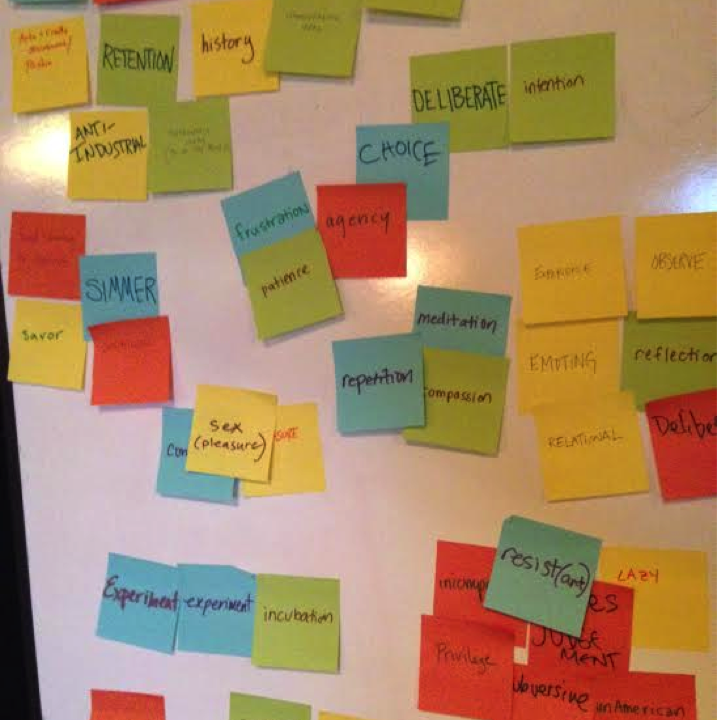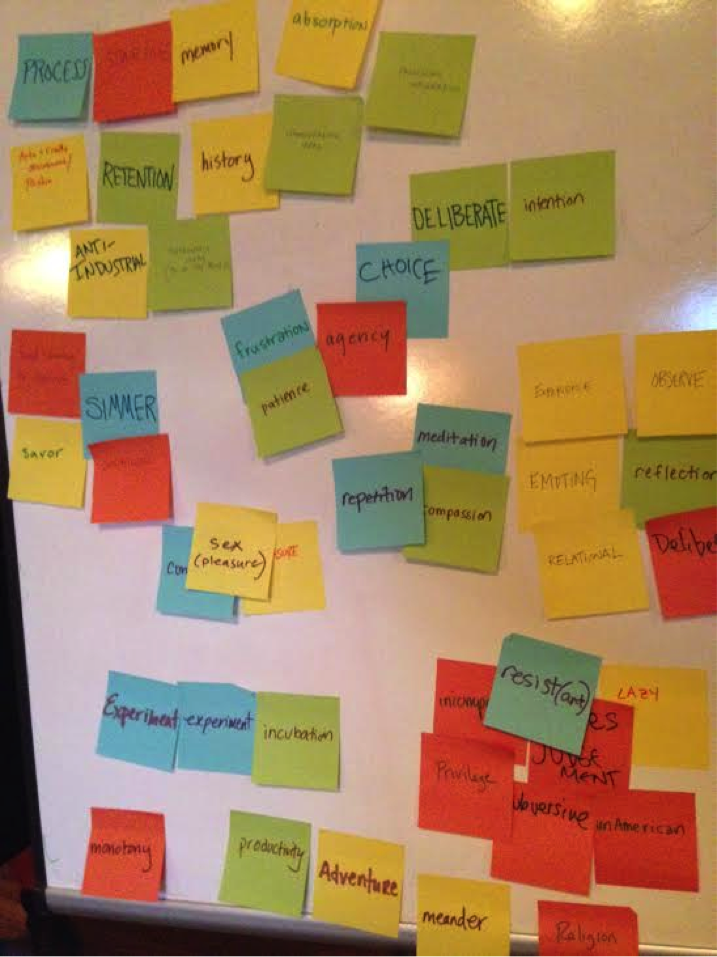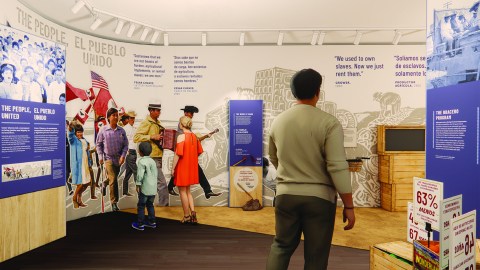
Jane Addams Hull-House Museum is one of three museums enrolled in the third round of Innovation Lab for Museums—a MetLife funded program offered by EmcArts in partnership with CFM. Hull-House has long been a hotbed of experimentation, a prime example of the 2.5% or so of our field who are innovators. In this guest post, interim director Lisa Junkin Lopez previews Hull-House’s “half-baked idea” that will come to fruition in the lab: the Slow Museum Project.
Oh! do not attack me with your watch. A watch is always too fast or too slow. I cannot be dictated to by a watch. –Jane Austen
I look at the clock as I sit down to write. It is 3:39pm and, this being Chicago in December, through my window I can see a fiery reflection of the sun beginning to set. I have been trying to write this post since 9am, but work has been busy. My time was spent helping to plan a community art workshop for a program next week, discussing concepts for a new exhibition, addressing HR matters, giving a director’s tour, welcoming new contractors to the museum, and reviewing a catalogue proof. I say this not to boast about my busy schedule, but to suggest that yours may look just the same. I believe that most of my colleagues in the museum field find themselves in a race against time each day, struggling to cross items off of a never-ending “to do” list. In a busy work environment where it feels like there are never enough resources to go around, how do you find the time to reflect? To innovate and dream?
Museum visitors have a similar problem. We see them daily, buzzing through galleries, checking off their “to view” lists, hurrying to see one more Impressionist drawing, one more ancient tool. Professional literature tells us to maintain visitor interest with rapidly changing exhibitions, media and technology, participatory activities and cafés. But do these solutions create better museums? When museums actively compete with the entertainment industry, do our visitors find time to reflect, innovate and dream? Aren’t these activities the ultimate goals of a museum visit?
At the Jane Addams Hull-House Museum, we are beginning to question the notion that museums and their workers should attempt to “keep up” with entertainment trends. We are critical of quick fixes that seek to capture visitors’ fleeting attention. At the same time, we reject the static, velvet-roped model of the past, uncomfortable with its elitism and irrelevance. We wonder, what would it mean to fully embrace the notion of a museum as a transgressive site of leisure, recreation, reflection and respite from the busyness of life?
Thanks to the Museum Innovation Lab Grant from MetLife, we have the privilege of devoting a year to this question. Six staff members and four community partners (an urban farmer, a museum and education activist, an artist and DJ, and a restorative justice practitioner) are experimenting with slowness. Together, we hope to determine what a museum would look like if it slowed down its own activities while encouraging profoundly pleasurable experiences and meaningful relationships.
We hypothesize that a slower approach to museum practices could dramatically increase JAHHM’s intrinsic value by producing a) more meaningful visitor experiences and community partnerships and b) increased reflection and evaluation of the museum’s work, ultimately resulting in a more sustainable and effective institution. Experiments could involve meandering choose-your-own-adventure unguided tours; an artist-made reflection room with meditative and musical components; playful, participatory visitor evaluations; incorporating slowness practices such as poetry-writing, kickball or communal eating into all public programs; staff recess; and more.
Traces of Slowness
There is a secret bond between slowness and memory, between speed and forgetting. –Milan Kundera
 |
| Image 1: Map of slowness by Slow Museum Project team at our first meeting. |
What exactly is slowness? Our team has devoted hours to this question alone, but one of our most exciting initiatives in the past year has guided our thinking on what a slow museum experience could be. An ongoing project at JAHHM is Alternative Labeling, wherein artists are invited to select an artifact from the museum’s collection and create a label in their artistic medium. The project asks, “Can a common museum label sensually engage us, inspire revolution and reform, or provide pleasure and comfort?” In 2012, artist Terri Kapsalis published a 40-page prose-poem as the alternative label for Jane Addams’ travel medicine kit. The logistics of this piece created serious problems… how could we expect visitors to read such a long label? Our staff responded by inviting visitors to spend 30 minutes reading the poem in Addams’ bedroom and serving them a cup of herbal tea. The resulting participatory experience provided a unique space for prolonged engagement and reflection, which we had never before accomplished.
 |
| Image 2: Participant response to Tea Experience |
As we continue our work, we have identified intellectual and activist lineages to guide us. These movements will be the basis of our research and inquiry as we proceed:
The Slow Food Movement:
The Slow Food movement is a global revolution that opposes the consumption of empty, cheap calories in fast food as well as the abysmal conditions under which it is produced. Advocates argue that fast food culture is unsustainable and must be literally and figuratively slowed down, allowing eaters to rediscover pleasure in food and the communal experience of eating. The movement asserts the necessity of taking the time to thoughtfully source ingredients and to advocate for all workers in the line of production, resulting in a transformed food system from farm to table. These ideals are deeply inspiring to JAHHM staff, which for nearly six years has organized programs about Slow Food.
The fight for play and leisure:
The residents of the Hull-House Settlement advocated for an expansive definition of citizenship and human rights that included access to leisure and play as critical modes of learning, socialization and freedom. Serving a working-class immigrant community consisting of more than 24 ethnic and racial groups, Hull-House founded Chicago’s first public playground and offered play-based progressive education, while simultaneously fighting for labor rights such as weekends and the eight-hour workday. We look to two Hull-House residents for their innovative work in these areas: Neva Boyd, a leader in the modern play movement who wrote more than a dozen books about games and emphasized the importance of recreation for all people; and Viola Spolin, who invented improvisational theater and believed that improvisation teaches individuals adaptive skills for overcoming difference.
These historical themes are the focus of a new exhibition at Hull-House opening in May 2014, entitled Rec Room. This yearlong exhibition will make direct connections between Hull-House’s history of play and leisure advocacy and similar movements in contemporary society.
Restorative Justice:
Restorative justice is a process and a movement to collectively identify and address wrongdoings between individuals and within the criminal justice system. This practice allows for all parties who have a stake in an offence, often including the greater community, to be a part of healing and restitution. It is intended in part to increase empathy and communication across lines of difference. Our education staff has trained in restorative justice practices over the past year and we believe that as a museum dedicated to America’s first woman to win the Nobel peace prize, the Hull-House can be an active part of Chicago’s peace building efforts. Our growing interest in restorative justice has also led us to consider mindfulness meditation and other sacred practices as possible resources.
Lingering Questions / Questions on Lingering
Certainty is a prison. – Billie Tsien
In this early stage of the project, we are faced with a number of tangled and paradoxical questions:
- Is slowness meaningful when it is mandated by an institution, or does it become oppressive?
- How do lenses of race, class and gender affect our visitors’ understandings of slowness?
- What is the relationship between slowness and pleasure? Between slowness and control?
- How can our staff complete this project in a way that doesn’t add extra work to our busy schedules?
- How should we assess slow programs in the museum?
- Is there a risk of dogmatic thinking or teaching as we experiment with and promote slowness?
- Is it truly possible or desirable for our visitors and staff to slow down? What might we lose in slowing down?
I invite you to weigh on the project and our lingering questions. Does your museum encourage activities that you consider to be “slow?” Are there traditions that you recommend we turn to as we continue our investigation? How do you personally find time for reflection as you complete your work?








Check out the Slow Art Day movement: http://www.slowartday.com/
Their next one is in April, and you can sign up to host or see who's participating.
I'm a fan of making space for slowness in an increasingly rushed society, but I recognize that it's not necessarily the best technique for everyone.
Rachel- thanks for your comment! Yes, I love the slow art day movement and all related efforts to look at art more closely. Here is a recent essay about slow looking that inspired me:
http://harvardmagazine.com/2013/11/the-power-of-patience
I very much commend you for addressing this topic. For a small museum, the desire to keep up with what larger museums are discussing can become very overwhelming. To know that a museum is exploring the idea of slowing down and creating environments in which both visitors and staff can find time for reflection is very encouraging. I will most look forward to reading answers to your questions about "imposed slowness" and how different groups of visitors experience slowness. Good luck and I look forward to reading about your progress.
Thank you Mark for your kind note. It is a true experiment, meaning that the project might fail. We'll keep you all posted!
What a wonderful world.
Of course, we must maintain a healthy approach to learning.
ART is so much and we have (take) so little time to reflect.
A true pleasure to read about your approach.
Marie
Lisa, ever since I learned about the Hull House's endeavor I've been excited and heartened and eagerly waiting to hear more. I think this is such an important issue in our fast-paced world, but I struggle with many of the same questions you're grappling with. Slowness has some of the same historical trouble that museums do, such as catering to the dominant white culture. I'm not sure how to address that, but I'm so glad someone is thinking about it.
I also love your recognition that slow has something to say for staff, too. Last year I did research about the well-being of museum professionals, and one of my findings was right in line with this issue. Staff reported valuing the opportunity to reflect – not just charging forward – but also indicated they didn't get to do as much of it as they would like. I think reflection is intimately tied to our well-being in giving us the opportunity to check in, re-identify who we are, think about where we've been and want to be going.
I'll be staying tuned for more news about your project (anything at AAM this year?) and wish you all the best as you proceed!
Lisa, check out the book, "The Convivial Museum," co-authored by Wendy Pollock and me. Your efforts really resonate with the underlying ideas in the book.
Oh my goodness, Kathy, YES. We love your book and have found it to be highly resonant with our work these days. We are grateful for thinkers like you and Wendy who push us out of our comfort zones and insist that another museum is possible! Thanks for the reminder. I'll make sure to bring my copy of your book to our upcoming staff retreat for reading and reflection.
Andrea, is your research on museum professionals available publicly? I would love to give it a read. We are struggling to find solutions to some of the most ingrained issues in the museum workplace, but we are trying. I would love to hear from others about their innovative solutions.
Please check out a similar article I wrote about a Slow Museum movement. It's on the Boston Society of Architects website:
http://www.architects.org/architectureboston/articles/%E2%80%9Cslow-museums%E2%80%9D-back-basics
Lisa, try this link, which should take you directly to a PDF of my thesis: https://digital.lib.washington.edu/dspace/bitstream/handle/1773/23533/Michelbach_washington_0250O_11485.pdf?sequence=1. I didn't get to delve as far into solutions as I'd have liked in the scope of my work, but that's definitely where the heart of it all lies. I also present a few ideas here on CFM: http://futureofmuseums.blogspot.com/2013/04/museo-mindfulness.html. Let me know if any of the ideas are helpful to you or you'd like to talk more via email.